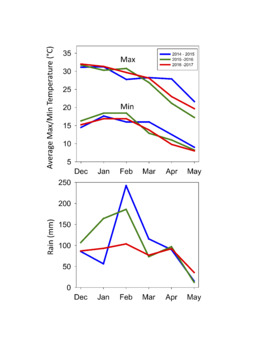Introgression of peanut smut resistance from landraces to elite peanut cultivars (Arachis hypogaea L.)

View/
Date
2019-02-08Author
Bressano, Marina
Massa, Alicia N.
Arias, René S.
De Blas, F.
Odinno, Claudio
Faustinelli, Paola Carmen
Soave, Sara J.
Soave, Juan H.
Perez Flores, María Antonieta
Sobolev, Víctor S.
Lamb, Marshall C.
Balzarini, Mónica
Buteler, Mario I.
Seijo, J. Guillermo
Metadata
Show full item recordAbstract
Smut disease caused by the fungal pathogen Thecaphora frezii Carranza & Lindquist is threatening the peanut production in Argentina. Fungicides commonly used in the peanut crop have shown little or no effect controlling the disease, making it a priority to obtain peanut varieties resistant to smut. In this study, recombinant inbred lines (RILs) were developed from three crosses between three susceptible peanut elite cultivars (Arachis hypogaea L. subsp. hypogaea) and two resistant landraces (Arachis hypogaea L. subsp. fastigiata Waldron). Parents and RILs were evaluated under high inoculum pressure (12000 teliospores g-1 of soil) over three years. Disease resistance parameters showed a broad range of variation with incidence mean values ranging from 1.0 to 35.0% and disease severity index ranging from 0.01 to 0.30. Average heritability (h2) estimates of 0.61 to 0.73 indicated that resistance in the RILs was heritable, with several lines (4 to 7 from each cross) showing a high degree of resistance and stability over three years. Evidence of genetic transfer between genetically distinguishable germplasm (introgression in a broad sense) was further supported by simple-sequence repeats (SSRs) and Insertion/Deletion (InDel) marker genotyping. This is the first report of smut genetic resistance identified in peanut landraces and its introgression into elite peanut cultivars.
La enfermedad del tizón causada por el hongo patógeno Thecaphora frezii Carranza & Lindquist está amenazando la producción de maní en Argentina. Los fungicidas comúnmente utilizados en el cultivo del maní han mostrado poco o ningún efecto en el control de la enfermedad, por lo que es prioritario obtener variedades de maní resistentes al tizón. En este estudio, se desarrollaron líneas endógamas recombinantes (RILs) a partir de tres cruces entre tres cultivares elite de maní susceptibles (Arachis hypogaea L. subsp. hypogaea) y dos variedades locales resistentes (Arachis hypogaea L. subsp. fastigiata Waldron). Los progenitores y las RILs se evaluaron bajo una alta presión de inóculo (12000 teliosporas g-1 de suelo) durante tres años. Los parámetros de resistencia a la enfermedad mostraron un amplio rango de variación con valores medios de incidencia que oscilaron entre el 1,0 y el 35,0% y el índice de gravedad de la enfermedad entre el 0,01 y el 0,30. Las estimaciones de heredabilidad media (h2) de 0,61 a 0,73 indicaron que la resistencia en las RILs era heredable, y varias líneas (de 4 a 7 de cada cruce) mostraron un alto grado de resistencia y estabilidad a lo largo de tres años. La evidencia de la transferencia genética entre germoplasma genéticamente distinguible (introgresión en un sentido amplio) fue apoyada además por repeticiones de secuencia simple (SSRs) y el genotipado de marcadores de Inserción/Deleción (InDel). Este es el primer informe sobre la resistencia genética al tizón identificada en las razas autóctonas de cacahuete y su introgresión en los cultivares de cacahuete de élite.
xmlui.dri2xhtml.METS-1.0.item-citation
Bressano, Marina; N. Massa, Alicia; Arias, Renee S.; de Blas, Francisco; Oddino, Claudio; Faustinelli, Paola C.; et al. (2019): Introgression of peanut smut resistance from landraces to elite peanut cultivars (Arachis hypogaea L.). PLOS ONE. Dataset. https://doi.org/10.1371/journal.pone.0211920
Collections
The following license files are associated with this item:
Except where otherwise noted, this item's license is described as Atribución-CompartirIgual 4.0 Internacional
Related items
Showing items related by title, author, creator and subject.
-
Introgression of peanut smut resistance from landraces to elite peanut cultivars (Arachis hypogaea L.)
Bressano, Marina; Massa, Alicia Noemí; Arias, Renee S.; De Blas, Francisco Javier; Oddino, Claudio Marcelo; Faustinelli, Paola Carmen; Soave, Sara; Soave, Juan H.; Pérez, María Alejandra; Sobolev, Victor S.; Lamb, Marshall C.; Balzarini, Mónica Graciela; Buteler, Mario I.; Seijo, José Guillermo (2019)Smut disease caused by the fungal pathogen Thecaphora frezii Carranza & Lindquist is threatening the peanut production in Argentina. Fungicides commonly used in the peanut crop have shown little or no effect controlling ... -
Additional file 2 of Genetic mapping and QTL analysis for peanut smut resistance
De Blas, Francisco Javier; Arias, René S.; Ballén-Taborda, Carolina; Mamani, Eva; Odinno, Claudio; Rosso, Melina; Costero, Beatriz P.; Bressano, Marina; Soave, Juan H.; Soave, Sara J.; Buteler, Mario I.; Seijo, J. Guillermo; Massa, Alicia N.; Bruno, Cecilia I. (SpringerNature, 2021-07-03)Additional file 2: List of 236 SNPs statistically significant (P = 0.01) resulting of a single marker-phenotype association between disease resistance trait and SNP markers. -
Additional file 8 of Genetic mapping and QTL analysis for peanut smut resistance
De Blas, Francisco Javier; Arias, René S.; Ballén-Taborda, Carolina; Mamani, Eva; Odinno, Claudio; Rosso, Melina; Costero, Beatriz P.; Bressano, Marina; Soave, Juan H.; Soave, Sara J.; Buteler, Mario I.; Seijo, J. Guillermo; Massa, Alicia N.; Bruno, Cecilia I. (SpringerNature, 2021-07-03)Additional file 8: Custom UNIX script for filtering the genotyping data generated in this study.




